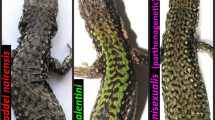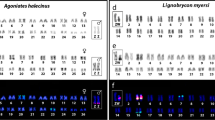Abstract
Pachytene oocytes from the two presumably most primitive orders (Paleognathae) among living birds were used to study the pairing behaviour and location of recombination nodules (RNs) in the sex pair. In the ratite Pterocnemia pennata (Rheiformes), the 42 analyzed ZW pairs show an average of 2.2 RNs distributed along 80% of the synaptonemal complex (SC) that covers the long arm of the acrocentric Z and W chromosomes in this homomorphic sex pair. In the tinamid Rynchotus rufescens (Tinamiformes), the 60 analyzed ZW pairs show an average of 1.35 RNs distributed along 66% of the SC covering most of the long arms of this visibly heteromorphic ZW pair. RNs are non-randomly distributed and show interference in both species, but in the tinamou they are restricted to a significantly smaller stretch. The discovery of an intermediate degree in the restriction of RN location, between the extremes of free recombination along most of the W in ratites and strict localization of a single RN in Neognath birds, suggests its relationship with the mechanism of sex chromosome differentiation among Aves.
Similar content being viewed by others
References
Aida T (1921) On the inheritance of color in a fresh-water fish, Aplocheilus latipes Temminck and Schlegel, with special reference to sex-linked inheritance. Genetics 6: 554–573.
Ansari HA, Takagi N, Sasaki M (1988) Morphological differentiation of sex chromosomes in three species of ratite birds. Cytogenet Cell Genet 47: 185–188.
Ausió J, Soley JT, Burger W, Lewis JD, Barreda D, Cheng M (1999) The histidine-rich protamine from ostrich and tinamou sperm. A link between reptile and bird protamines. Biochemistry 38: 180–184.
Baverstock PR, Adams M, Polkinghorne RW, Gelder M (1982) A sex linked enzyme in birds — Z-chromosome conservation but no dosage compensation. Nature (London) 296: 763–766.
Beçak W, Beçak ML, Nazareth HRS, Ohno S (1964) Close karyological kinship between the reptilian suborder Serpentes and the class Aves. Chromosoma 15: 606–617.
Belterman RHR, De Boer LEM (1984) A karyological study of 55 species of birds, including 39 karyotypes new to cytology. Genetica 65: 39–82.
Bull JJ (1983) Evolution of Sex Determining Mechanisms. Menlo Park, California: The Benjamin/Cummings Publishing Company, Inc.
Charlesworth B (1991) The evolution of sex chromosomes. Science 251: 1030–1033.
Christidis L (1990) Animal cytogenetics. Chordata 3, B. Aves. Berlin, Stuttgard: Gebrüder Borntraeger.
Cooper A, Penny D (1997) Mass survival of birds across the cretaceous-tertiary boundary: molecular evidence. Science 275: 1109–1112.
Cracraft J (1981) Toward a phylogenetic classification of the recent birds of the world (Class Aves). Auk 98: 681–714.
De Boer LEM (1980) Do the chromosomes of the kiwi provide evidence for a monophyletic origin of the ratites? Nature 287: 84–85.
De Boer LEM (1984) New developments in vertebrate cytotaxonomy. VIII. A current list of references on avian karyology. Genetica 65: 3–37.
Ellegren H (1996) First gene on the avian W chromosome (CHD) provides a tag for universal sexing of non-ratites birds. Proc R Soc Lond B 263: 1635–1641.
Fridolfsson AK, Cheng H, Copeland NG et al. (1998) Evolution of the avian sex chromosomes from an ancestral pair of autosomes. Proc Natl Acad Sci 95: 8147–8152.
Griffiths R, Holland PWH (1990) A novel avian W chromosome DNA repeat sequence in the lesser black-backed gull (Larus fuscus). Chromosoma 99: 243–250.
Haig J (1978) The accumulation of deleterious genes in a population — Muller's ratchet. Theor Pop Biol 14: 251–267.
Matsuda M, Matsuda C, Hamaguchi S, Sakaizumi M (1998) Identification of the sex chromosomes of the medaka, Oryzias latipes, by fluorescence in situ hybridization. Cytogenet Cell Genet 82: 257–262.
Mizuno S, Saitoh Y, Nomura O et al. (1993) Sex-specific sequences in Galliformes and their application to the study of sex differentiation. In: Etches RJ, Gibbins AM, eds. Manipulation of the Avian Genome. Boca Raton: CRC Press, pp 257–274.
Ogawa A, Murata K, Mizuno S (1998) The location of Z-and W-linked markers genes and sequences on the homomorphic sex chromosomes of the ostrich and the emu. Proc Natl Acad Sci USA 95: 4415–4418.
Ohno S (1967) Sex Chromosomes and Sex-linked Genes. Berlin: Springer Verlag.
Orr HA, Kim Y (1999) An adaptive hypothesis for the evolution of the Y chromosome. Genetics 150: 1693–1698.
Peters A, Plug AW, van Wugt MJ, de Boer P (1997) A drying-down technique for the spreading of mammalian meiocytes from the male and female germline. Chromosome Res 5: 66–71.
Pigozzi MI (1999) Origin and evolution of the ZW pair in birds. Biocell 23: 1–17.
Pigozzi MI, Solari AJ (1997) Extreme axial equalization and wide distribution of recombination nodules in the primitive ZW pair of Rhea americana (Aves, Ratitae). Chromosome Res 5: 421–428.
Pigozzi MI, Solari AJ (1998) Germ cell restriction and regular transmission of an accessory chromosome that mimics an XY body in the zebra finch, Taeniopygia guttata. Chromosome Res 6: 105–113.
Pigozzi MI, Solari AJ (1999a) Equal frequencies of recombination nodules in both sexes of the pigeon suggest a basic difference with eutherian mammals. Genome 42: 315–321.
Pigozzi MI, Solari AJ (1999b) Recombination nodule mapping and chiasma distribution in spermatocytes of the pigeon, Columba livia. Genome 42: 308–314.
Rahn IM, Solari AJ (1986) Recombination nodules in the oocytes of the chicken, Gallus domesticus. Cytogenet Cell Genet 43: 187–193.
Rice W (1994) Degeneration of a non-recombining chromosome. Science 263: 230–232.
Ryuzaki M, Hanada H, Okumoto H, Takizawa N, Nishioka N (1999) Evidence for heteromorphic sex chromosomes in males of Rana tagoi and Rana sakuraii in Nishitama district of Tokyo (Anura: Ranidae). Chromosome Res 7: 31–42.
Saitoh Y, Mizuno S (1992) Distribution of XhoI and EcoRI family repetitive DNA sequences into separate domains in the chicken W chromosome. Chromosoma 101: 474–477.
Schmid M, Olert J, Klett C (1979) Chromosome banding in Amphibia.III. Sex chromosomes in Triturus. Chromosoma 71: 29–55.
Sherman JD, Stack SM (1995) Two-dimensional spreads of the synaptonemal complexes from solanaceous plants. VI. High-resolution recombination nodule map for the tomato (Lycopersicum esculentum). Genetics 141: 683–708.
Sibley CG, Ahlquist JE (1990) Phylogeny and Classification of Birds. A Study in Molecular Evolution. Yale University Press.
Solari AJ (1977) Ultrastructure of the synaptic autosomes and the ZW bivalent in chicken oocytes. Chromosoma 64: 155–165.
Solari AJ (1992) Equalization of Z and Waxes in chicken and quail oocytes. Cytogenet Cell Genet 59: 52–56.
Solari AJ (1993) Sex Chromosomes and Sex Determination in Vertebrates. Boca Raton, Florida: CRC Press.
Solari AJ, Pigozzi MI (1993) Recombination nodules and axial equalization in the ZW pairs of the Peking duck and the Guinea fowl. Cytogenet Cell Genet 64: 268–272.
Solari AJ, Dresser ME (1995) High resolution cytological localization of the XhoI and EcoRI repeat sequences in the pachytene ZW bivalent of the chicken. Chromosome Res 3: 87–93.
Solari AJ, Fechheimer NS, Bitgood JJ (1988) Pairing of ZW gonosomes and the localized recombination nodule in two Z-autosome translocations in Gallus domesticus. Cytogenet Cell Genet 48: 130–136.
Solovei I, Gaginskaya E, Hutchison N, Macgregor H (1993) Avian sex chromosomes in the lampbrush form: the ZW lampbrush bivalents from six species of birds. Chromosome Res 1: 153–166.
Stephos K, Arrighi FE (1971) Heterochromatic nature of W chromosome in birds. Exp Cell Res 68: 228–229.
Sybenga J (1975) Meiotic Configurations. Berlin: Springer Verlag.
Author information
Authors and Affiliations
Corresponding author
Rights and permissions
About this article
Cite this article
Pigozzi, M.I., Solari*, A.J. The ZW Pairs of Two Paleognath Birds From Two Orders Show Transitional Stages of Sex Chromosome Differentiation. Chromosome Res 7, 541–551 (1999). https://doi.org/10.1023/A:1009241528994
Issue Date:
DOI: https://doi.org/10.1023/A:1009241528994




